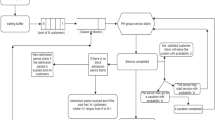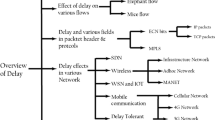Abstract
In order to support transmissions of multimedia data (high data rate and burst) with performance guarantees in a wideband CDMA system, it is crucial to design a judicious algorithm for burst data admission control and scheduling. However, in the current literature there are only simple techniques (such as first-come-first-served and equal sharing) suggested for tackling the problem. Indeed, these existing schemes are not designed for optimizing the precious bandwidth resources while providing performance guarantees (e.g., a user admitted with a certain data rate can enjoy the assigned rate without interruption). In this paper, we first present our novel integer programming formulation of the burst data admission control and scheduling problem. The objective of the optimization can be maximizing the utilization of the bandwidth resources or minimizing the delays of the user transmissions. Taking into account all the important factors such as mobility, power control, and soft handoff, our formulation induces an algorithm for generating an optimal admission control solution which consists of: (1) the burst data rate (in terms of the number of channels); (2) the burst duration; and (3) the burst start time. For practical implementation, we also suggest a near-optimal version of the algorithm, which is evaluated via static and dynamic simulations, and comparisons with two existing schemes.
Similar content being viewed by others
References
W.C. Chan, E. Geraniotis and K. Etemad, Performance analysis of ISMA for short burst data service in wireless CDMA networks, in: Proceedings of ICC'99 (1999) pp. 1115–1120.
R.P. Ejzak, D.N. Knisely, S. Kumar, S. Laha and S. Nanda, BALI: A solution for high-speed CDMA data, Bell Labs Technical Journal (Summer 1997) 134–151.
V.K. Garg, IS-95 CDMA and cdma2000 (Prentice-Hall, 2000).
N. Guo, S.D. Morgera and P. Mermelstein, Common Packet Data Channel (CPDC) for integrated wireless DS-CDMA networks, IEEE Journal on Selected Areas in Communications 14(4) (May 1996) 735–749.
W. Huang and V.K. Bhargava, Performance evaluation of a DS/CDMA cellular system with voice and data services, in: Proceedings of PIMRC'96 (1996) pp. 588–592.
C.-L. I and S. Nanda, Load and Interference Based Demand Assignment (LIDA) for integrated services in CDMA wireless systems, in: Proceedings of GLOBECOM'96 (1996) pp. 235–241.
D.N. Knisely, S. Kumar, S. Laha and S. Nanda, Evolution of wireless data services: IS-95 to cdma2000, IEEE Communications Magazine (October 1998) 140–149.
D.N. Knisely, Q. Li and N.S. Ramesh, cdma2000: A third-generation radio transmission technology, Bell Labs Technical Journal (July – September 1998) pp. 63–78.
S. Kumar and S. Nanda, High data-rate packet communications for cellular networks using CDMA: Algorithms and performance, IEEE Journal on Selected Areas in Communications 17(3) (March 1999) 472–492.
Y.-K. Kwok, A quasi-static cluster-computing approach for dynamic channel assignment in cellular mobile communication systems, in: Proceedings of VTC'99 Fall, Vol. 4 (September 1999) pp. 2343–2347.
V.K.N. Lau, Channel capacity and error exponents of variable rate adaptive channel coding for Rayleigh fading channels, IEEE Transactions on Communications 47(9) (September 1999) pp. 1345–1356.
V.K.N. Lau, Performance of variable rate bit-interleaved coding for high bandwidth efficiency, in: Proceedings of VTC'2000,Vol.3 (May 2000) pp. 2054–2058.
V.K.N. Lau and Y.-K. Kwok, Synergy between adaptive channel coding and media access control for wireless ATM, in: Proceedings of VTC'99 Fall, Vol. 3 (September 1999) pp. 1735–1739.
V.K.N. Lau and Y.-K. Kwok, CHARISMA: A novel channel-adaptive TDMA-based multiple access control protocol for integrated wireless voice and data services, in: Proceedings of the Second IEEE Wireless Communications and Networking Conference (WCNC'2000),Vol.2 (September 2000) pp. 507–511.
V.K.N. Lau and Y.-K. Kwok, Jointly adaptive high-data-rate burst admission control for wideband CDMA system, submitted for publication.
S. Manning, A. Gutierrez and M. Wang, A short data burst mechanism for third generation CDMA wireless packet data, in: Proceedings of VTC'99 (1999) pp. 521–525.
A. Mawira, Models for the spatial correlation functions of the (log)-normal component of the variability of VHF/UHF field strength in urban environment, in: Proceedings of the Third IEEE International Conference on Personal, Indoor, and Mobile Radio Communications (October 1992) pp. 436–440.
S. Nanda, K. Balachandran and S. Kumar, Adaptation techniques in wireless packet data services, IEEE Communications Magazine (January 2000) 54–64.
R. Prasad and T. Ojanpera, A survey on CDMA: Evolution towards wideband CDMA, in: Proceedings of IEEE International Conference on Spread Spectrum Techniques and Applications (1998) pp. 323–331.
A. Sampath and J.M. Holtzman, Access control of data in integrated voice/data CDMA systems: Benefits and tradeoffs, IEEE Journal on Selected Areas in Communications (October 1997) 15(8) 1511–1526.
A.J. Viterbi, CDMA: Principles of Spread Spectrum Communication (Addison-Wesley, 1995).
Author information
Authors and Affiliations
Rights and permissions
About this article
Cite this article
Kwok, YK., Lau, V.K. On Admission Control and Scheduling of Multimedia Burst Data for CDMA Systems. Wireless Networks 8, 495–506 (2002). https://doi.org/10.1023/A:1016594213290
Issue Date:
DOI: https://doi.org/10.1023/A:1016594213290




